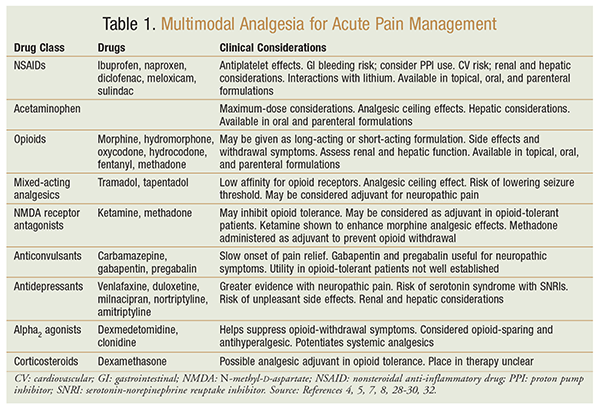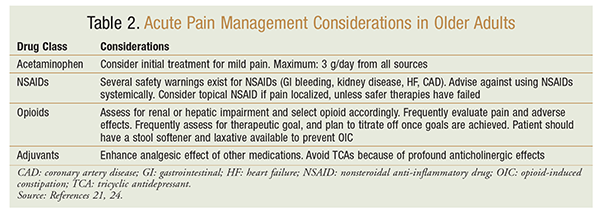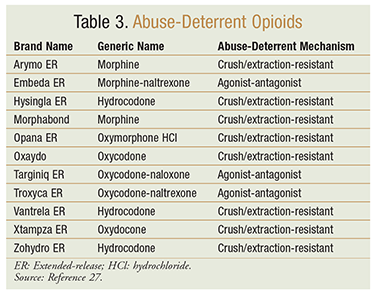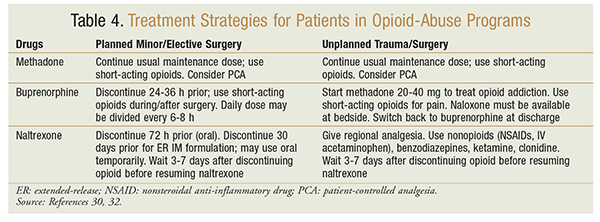2015 Peer Reviewed How Does Using Nsaids and Hydrocodone Relate Back to the Pathophysiology of Pain
Us Pharm. 2017;42(3):28-32.
ABSTRACT: Prescription opioid use has significantly increased globally in the past 2 decades and has led to an increased number of patients who have become tolerant to opioids. Analgesia in this patient population poses a challenge, and at that place is a risk of undertreatment. In addition to providing constructive analgesia, it is of import to prevent withdrawal symptoms and address whatsoever related psychosocial issues. Therefore, a multidisciplinary and multimodal arroyo in hurting direction is necessary to provide effective analgesia in this patient population.
Prescription opioids are some of the near commonly prescribed pain medications in the United States, and they are unremarkably the drugs of choice for managing moderate-to-severe hurting. The number of opioids prescribed in the U.South. skyrocketed from 76 million in 1991 to 216 one thousand thousand in 2012, with one-half of opioid sales accounting for treatment of chronic noncancer pain.1,ii
The FDA defines a patient every bit opioid tolerant if for at least one week he or she has been receiving oral morphine 60 mg/24-hour interval; transdermal fentanyl 25 mcg/60 minutes; oral oxycodone 30 mg/day; oral hydromorphone viii mg/day; oral oxymorphone 25 mg/24-hour interval; or an equianalgesic dose of any other opioid.3 Opioid tolerance implies a lesser susceptibility to the effects of opioids—both therapeutic and adverse—and it may develop in individuals with long-term utilise of opioids.3-6 Patients who are prescribed opioids for management of cancer pain or chronic noncancer pain or who have an opioid habit may become opioid tolerant.5,6
Acute pain may present postoperatively considering of the traumatic surgical injury, or in other acute weather. Astute pain in patients with opioid tolerance makes pain management a challenge, and perhaps ane of the greatest risks associated with pain direction in this population is the risk of undertreatment due to stigma and bias. Further, data on pain management in this patient population are limited.7 This review focuses primarily on acute pain management in opioid-tolerant patients, including those with chronic opioid use for chronic noncancer pain and those who abuse opioids.
PATHOPHYSIOLOGY
The awareness of hurting occurs via nociception, a process of communication between the site of tissue damage and the cardinal nervous system (CNS).8,nine A baneful stimulus (mechanical, thermal, or chemical) activates nociceptors, or free nervus endings (A-delta and C fibers), in the peripheral fretfulness.9 This stimulus is and so transduced into a sensor potential that, if high enough, triggers action potential that is transmitted down the axon to nerves located in the dorsal horn of the spinal cord or brainstem.9 The nerve impulses in the dorsal horn may and so travel up the ascending pathway to the thalamocortical system, where perception—including information on location, intensity, and elapsing—occurs.viii,9 Hurting modulation takes identify via the descending pathway from the encephalon to the neurons in the dorsal horn of the spinal cord.viii,9
Neuropathic pain differs from nociceptive pain in that neuropathic pain results from abnormal processing of nerve impulses in the peripheral nervous system and CNS, whereas nociceptive pain results from noxious stimulation of free nerve endings in the tissue.8,ix
It is theorized that, with chronic opioid exposure, extensive adaptations occur at the cellular and synaptic levels, leading to opioid tolerance.4 Opioid tolerance is thought to develop from the desensitization, internalization, and downregulation of opioid receptors.four This phenomenon should non be confused with opioid addiction, in which a physical dependence results from receptor counteradaptation in conjunction with a drug-seeking behavior.iv Physical dependence is a state of accommodation that is manifested past drug-specific withdrawal syndrome upon abrupt change or discontinuation of the drug.4
A status that overlaps with opioid tolerance is opioid-induced hyperalgesia (OIH). However, the difference betwixt them is that in opioid tolerance, an increased corporeality of opioids is necessary to relieve the pain, whereas in OIH, the same amount of opioid causes paradoxically worse pain.5 It is of import for both clinicians and patients to empathise the difference between opioid tolerance and OIH.
CONSEQUENCES OF UNRELIEVED Hurting
Pain is subjective, which makes it hard to assess the degree of severity. Generally, acute pain is a multidimensional experience, usually resulting from trauma, that lasts no longer than 3 to 6 months, merely it has the potential to get more complex, both physiologically and psychologically.10,11 Literature suggests that undertreatment of astute pain may lead to decreased responsiveness to opioid analgesics, thereby making subsequent pain control more difficult.
Uncontrolled pain affects various systems, including the CNS and the cardiovascular, pulmonary, gastrointestinal, renal, immunologic, and muscular systems. Additionally, overall recovery is significantly afflicted, and progression to chronic pain (pain that is persistent in nature, lasting longer than 6 months) may result.12 The presence of two or more than comorbid conditions further complicates pain, and parallels can be drawn betwixt chronic hurting and other chronic atmospheric condition, such as indisposition, cognitive turn down, and depression.
Pain and depression are two of today'due south most critical public-wellness issues. This comorbidity is associated with a greater burden to the patient than for either condition alone.13 Approximately 50% of patients with depression report experiencing pain symptoms.14 In fact, patients with comorbid depression accept greater hurting, a worse prognosis, and more functional disability.xv When pain is not accordingly treated, postanesthesia intendance-unit stays are prolonged, hospital discharges are delayed, and unanticipated admissions following ambulatory surgery or readmissions occur.12
TREATMENT GOALS FOR ACUTE Pain
Equally outlined in the clinical practice guidelines, goals for astute hurting management include 1) early intervention, with frequent regimen adjustments for uncontrolled pain; 2) reduction of pain to an acceptable level determined by the patient; and 3) facilitation of recovery from the underlying illness or injury.16
It is also of import to aim for prevention of adverse drug events and opioid-withdrawal symptoms; improved quality of life; and assistance with whatever social, psychiatric, or behavioral components that may hinder effective pain management.4,five,8 Ultimately, the goal is to reach a regimen that adequately relieves the patient's hurting without whatever undue handling brunt, such equally harmful side furnishings.
Arroyo TO Hurting MANAGEMENT
Acute pain management in opioid-tolerant patients often requires a multimodal and multidisciplinary approach; therefore, it is necessary to maintain careful coordination and constructive communication between disciplines, as well as between each bailiwick and the patient.17 Early identification through a careful assessment and history in patients at take a chance for opioid tolerance is essential for adequate pain-management planning.17,18 Upon identification of such a patient, steps should be taken to codify an effective treatment plan in the preoperative or similarly acute phase to ensure adequate pain management during the acute period and prevention of withdrawal symptoms or other treatment-related complications.17,18 Similarly, appropriate discharge and transition-of-care planning should be considered.17,eighteen
As with the general patient population, a multimodal pain regimen with a combination of pharmacologic and nonpharmacologic approaches is ideal. Opioids remain the drug of option for severe hurting and are a mutual choice for moderate pain, but multimodal pain management with acetaminophen, nonsteroidal anti-inflammatory drugs (NSAIDs), and adjuvant medications (Table 1) remains the mainstay of effective analgesia. In gild to prevent delays in care and the risk of untreated pain, analgesics should exist administered on a scheduled basis rather than an as-needed ground.

Opioids
Patients with opioid tolerance will probable require more opioids than opioid-naïve patients.4,5 Opioids should be administered in an amount sufficient to attain analgesia without harmful side furnishings, such as excessive sedation or respiratory depression.4 Opioid rotation (substitution with a different opioid when one opioid in increasing doses does not provide desired analgesic consequence) may be employed when needed in patients with opioid tolerance, as cross-tolerance is uncommon.4,5 The recommended approach for opioid rotation is to initially substitute with one-half to 2-thirds equianalgesic opioid and so monitor for prophylactic and effectiveness.iv It should be kept in heed that switching from a long-acting opioid to a short-acting opioid may precipitate withdrawal symptoms in the patient.4
Opioid-related side effects are less common in opioid-tolerant patients; nevertheless, if opioid therapy is selected as analgesia of choice in these patients, monitoring for side effects or complications related to opioid therapy remains just every bit important as with the general population.iv,5 The risk of adverse drug events is greater with rapid escalation of opioid therapy, even in opioid tolerance.v In fact, opioid-tolerant patients are said to be more susceptible to the sedative properties of opioids and should be monitored.5,17
In the selection of opioids as analgesia of choice, patient-controlled analgesia (PCA) offers a user-friendly method of delivery, every bit information technology minimizes the run a risk of undertreatment, allows self-titration, and negates possible conflicts with nursing staff.four,5 Additionally, a retrospective study found that opioid-tolerant patients who had PCA were less likely to report agin effects—with the exception of sedation—compared with the opioid-naïve group.nineteen By nature of their condition, opioid-tolerant patients probable crave higher bolus doses with PCA.
Recognizing Acute Withdrawal
Opioid withdrawal can occur in opioid-dependent patients receiving a reduced amount of their usual opioid or using an opioid antagonist. The Diagnostic and Statistical Manual of Mental Disorders, Fifth Edition, lists four criteria for opioid withdrawal: 1) previously heavy and prolonged opioid use ceases or is reduced, or an opioid adversary is administered after a period of opioid utilise; 2) at least three signs and symptoms (due east.one thousand., dysphoric mood, nausea, vomiting, diarrhea, muscle aches, rhinorrhea, lacrimation, pupillary dilation, piloerection, sweating, yawning, fever, insomnia) develop within minutes to several days of the previous criteria; three) symptoms are clinically significant or impair social, occupational, and other important areas of functioning; and 4) signs and symptoms cannot be attributed to any other medical or mental disorder, including withdrawal from or intoxication with another drug.20
NSAIDs and Acetaminophen
NSAIDs and acetaminophen are often included in the multimodal approach to hurting management in opioid-naïve patients considering of their opioid-sparing holding. Similarly, this approach should be employed in maximally tolerated doses in opioid-tolerant individuals.17 Information technology is suggested that apply of these agents will subtract the need and increase the time for rescue medications required for quantum hurting.vii Both subgroups of medications may be given orally or parenterally.
SPECIAL POPULATIONS AND ACUTE PAIN Management
Elderliness
Currently, older adults contain the fastest-growing segment of the world's population. The number of people worldwide aged 65 years and older was estimated at 508 1000000 in 2008, and past 2040 that number will increase to 1.three billion.21 With increasing age, the incidence and prevalence of certain pain syndromes likewise increase. Co-ordinate to the CDC, more than 2.eight meg injuries treated annually in emergency departments effect from falls.22
Older adults are frequently untreated or undertreated for hurting.23 Barriers to effective hurting management in older adults include difficulty in adequately assessing pain, underreporting of pain, atypical manifestations of pain, and misconceptions about tolerance and addiction to opioids.23 Additionally, handling of acute pain in older adults tin can be challenging given changes in pharmacodynamics and pharmacokinetics.23 Older adults take increased fat mass, decreased muscle mass, and decreased body water, all of which have important implications for drug distribution. A predictable age-related refuse in CYP450 function plays a major role in drug metabolism. In improver, polypharmacy is a well-known issue in this population. Multidisciplinary and multimodal approaches to treatment are recommended to optimize handling response without jeopardizing safety. It is as well of import to consider the frailty of older adults and the risk of falls.
The medication lists of all older adults should be reviewed comprehensively for drug interactions and CNS-altering agents. In 2015, the Beers Criteria were updated to note that opioids should exist avoided if the patient has a history of falls and fractures or is taking 3 or more CNS-active drugs concomitantly, which increases the risk of falls.24 It is besides important to assess renal and/or hepatic part when designing a hurting regimen. The proverb "Outset low and go wearisome" should be followed. Peradventure the nigh important element is to reassess and go on to titrate up or down based on the patient'due south response, as well equally tolerability.
Additionally, an agreement of the different types of pain (nociceptive vs. neuropathic) volition guide the employ of nonopioids versus adjuvant medications. Adjuvants and topical agents are ideal for geriatric patients to reduce the opioid requirement and associated risks.23 Tabular array ii outlines considerations for acute pain management in older adults.21,24 Using a multifariousness of nonopioid agents can consequence in favorable outcomes in the treatment of pain in older adults.

Opioid Abuse
Opioid misuse and dependence among prescription-opioid patients continues to rise in the U.South. Opioid addiction is driving this epidemic, with twenty,101 overdose deaths related to prescription pain relievers.25 Clinicians should exist aware of factors associated with opioid abuse that can help predict opioid dependence. Boscarino and colleagues, in a study involving patients receiving long-term opioid therapy, institute that opioid dependence is associated with five main factors: historic period <65 years (odds ratio [OR] 2.33, P = .001), depression (OR 1.29, P = .022), psychotropic medication (OR ane.73, P = .006), history of severe dependence (OR i.85, P = .001), and previous opioid abuse (OR 3.81, P <.001).26 It is critically of import to obtain thorough patient histories in lodge to be amend equipped to discover aberrant behaviors. These take chances factors have also been noted to promote perceptions among healthcare providers that can lead to the undertreatment of truthful pain.
Given the growing epidemic of opioid abuse and misuse, several land boards of pharmacy have implemented prescription-monitoring programs that tin can help providers identifying aberrant behaviors in the acute-care setting. Additionally, the FDA is encouraging the development of opioid formulations with corruption-deterrent (AD) properties and mixed agonist-antagonist opioids (Table 3) to help combat the opioid epidemic.27 Formulations with Advertizing properties target the known or expected routes of abuse, such equally crushing in gild to snort and dissolving in order to inject. However, most of these newer formulations are extended-release (ER) and are more appropriate for patients requiring long-term opioid use. The FDA notes that long-acting and ER opioid formulations are appropriate simply for opioid-tolerant patients.three ER opioid formulations with AD properties, although usually more than expensive than generic opioids, are excellent for managing pain in patients at risk for opioid abuse or misuse.

Long-Term Opioid Agonist Therapy
Increasing numbers of patients with opioid addiction are receiving opioid agonist therapy (OAT) with methadone and buprenorphine, and some are receiving OAT combined with naloxone or merely naltrexone alone. (Naloxone and naltrexone are pure opioid antagonists that block all types of opioid receptors; they can be orally administered and have a long duration of action.) Every bit a outcome, providers will more oftentimes meet OAT patients who have developed painful weather condition that need effective treatment strategies. Long-term OAT patients are at increased risk for pain undertreatment.28 NSAIDs and acetaminophen are recommended for treating astute pain; yet, if the pain is moderate-to-severe, opioid analgesics may exist required for effective control.28
Although it is known that opioid-dependent patients take a reduced pain threshold,28-30 several misconceptions impede constructive hurting management: 1) maintenance opioids (eastward.yard., methadone) provide analgesia; 2) addiction relapse may occur with the use of opioids for analgesia; 3) respiratory and CNS low will probable develop with boosted opioid use; and 4) reporting of pain may be a manipulation effort.28 In reality, many patients are reluctant to take opioid analgesics in legitimate situations because of fear of relapse.thirty It is suggested that the stress associated with unrelieved hurting is more probable than adequate analgesia to trigger relapse.31
This poses a challenge for acute pain treatment but also creates opportunities for instruction, which is crucially of import for both patients and clinicians. A thorough understanding of the mechanisms of activity of agents used to care for pain and to manage habit is paramount. This is particularly true in patients in opioid-commutation programs. For example, patients on extremely loftier doses of methadone may receive little benefit from additional opioids because opioid receptors are occupied by methadone, and analgesia from methadone does not last long.17 Nevertheless, splitting the daily methadone dose for administration every eight hours may exist considered to accomplish analgesic benefit.17 Some other consideration is the use of small doses of methadone every bit needed in opioid-addicted patients who are currently using illicit opioids to prevent withdrawal symptoms.17
Providers should build a relationship of trust with these patients. The patient's pain-management plan should exist discussed in a nonjudgmental, reassuring fashion. The patient should be encouraged to provide a detailed medication history, including prescribed and illicit drugs, in order to promote effective pain management in astute situations. Besides, opioid cantankerous-tolerance and increased hurting sensitivity, which likely volition lead to higher opioid doses required in shorter intervals, should exist assessed. Use of a mixed agonist-adversary opioid for acute hurting management should exist avoided because these agents can precipitate astute withdrawal symptoms. Maintenance dosing of methadone or buprenorphine should be continued. Any boosted analgesia should exist provided using a multimodal arroyo, including nonopioids such every bit NSAIDs or IV acetaminophen, adjuvant therapies that raise opioids' issue, and brusque-acting opioids.iv,32 Adjuvants include ketamine, which has opioid-sparing effects due to N-methyl-d-aspartate receptor antagonism, and blastoffii-adrenoceptor stimulators such as clonidine, to reduce opioid-withdrawal symptoms.five,28-30,32 Other handling strategies for patients in opioid-abuse programs are given in TABLE 4.thirty,32

CONCLUSION
Acute pain management presents a challenge in patients with opioid tolerance, and undertreatment is a risk in this population. Acute pain should exist managed multimodally and with effective coordination of the multidisciplinary team to best meet the patient's analgesic needs. Patients receiving long-term OAT with methadone or buprenorphine should proceed to receive maintenance therapy and may require additional treatment via a multimodal approach, including short-acting opioids, for acute pain management.
REFERENCES
1. Volkow ND. Harnessing the ability of science to inform substance abuse and addiction policy and practise. www.drugabuse.gov/nearly-nida/legislative-activities/testimony-to-congress/2015/harnessing-power-scientific discipline-to-inform-substance-corruption-addiction-policy-practice. Accessed November 29, 2016.
two. Baldwin G. Overview of the public health burden of prescription drug and heroin overdoses. www.fda.gov/downloads/drugs/newsevents/ucm454826.pdf. Accessed November 29, 2016.
3. FDA. Extended-release (ER) and long-interim (LA) opioid analgesics Hazard Evaluation and Mitigation Strategy (REMS). world wide web.fda.gov/downloads/drugs/drugsafety/postmarketdrugsafetyinformationforpatientsandproviders/ucm311290.pdf. Accessed January 31, 2017.
4. Mehta V, Langford RM. Acute pain management for opioid dependent patients. Anaesthesia. 2006;61:269-276.
5. Huxtable CA, Roberts LJ, Somogyi AA, MacIntyre PE. Astute pain management in opioid-tolerant patients: a growing challenge. Anaesth Intensive Care. 2011;39:804-823.
6. Stokowski LA. Adult cancer pain: role ii—the latest guidelines for hurting direction. Medscape. www.medscape.com/viewarticle/733067. Accessed February 10, 2017.
7. Shah S, Kapoor Southward, Durkin B. Analgesic direction of acute pain in the opioid-tolerant patient. Curr Opin Anaesthesiol. 2015;28:398-402.
8. Prince V. Pain management in patients with substance-use disorders. www.accp.com/docs/bookstore/psap/p7b05.sample03.pdf. Accessed Feb 10, 2017.
nine. Schaible HG, Richter F. Pathophysiology of hurting. Langenbecks Arch Surg. 2004;389:237-243.
ten. Fine PG. Long-term consequences of chronic pain: mounting evidence for pain every bit a neurological illness and parallels with other chronic disease states. Pain Med. 2011;12:996-1004.
eleven. Bingham B, Ajit SK, Blake DR, Samad TA. The molecular basis of pain and its clinical implications in rheumatology. Nat Clin Pract Rheumatol. 2009;5:28-37.
12. Baratta JL, Schwenk ES, Viscusi ER. Clinical consequences of inadequate pain relief: barriers to optimal pain management. Plast Reconstr Surg. 2014;134(4 suppl ii):S15-S21.
thirteen. Arnow BA, Hunkeler EM, Blasey CM, et al. Comorbid depression, chronic pain, and disability in master care. Psychosom Med. 2006;68:262-268.
fourteen. Katona C, Peveler R, Dowrick C, et al. Hurting symptoms in depression: definition and clinical significance. Clin Med (Lond). 2005;5:390-395.
xv. Goesling J, Clauw DJ, Hassett AL. Pain and depression: an integrative review of neurobiological and psychological factors. Curr Psychiatry Rep. 2013;15:421.
sixteen. Wilson PR. Clinical exercise guideline: acute hurting direction. Clin J Hurting. 1992;8:187-188.
17. Schug SA. Acute pain management in the opioid-tolerant patient. Pain Manag. 2012;2:581-591.
xviii. De Andres J, Fabregat-Cid G, Asensio-Samper JM, et al. Direction of acute pain in patients on treatment with opioids. Pain Manag. 2015;v:167-173.
19. Rapp SE, Set up LB, Nessly ML. Acute pain direction in patients with prior opioid consumption: a case-controlled retrospective review. Pain. 1995;61:195-201.
20. Hasin DS, O'Brien CP, Auriacombe Yard, et al. DSM-five criteria for substance employ disorders: recommendations and rationale. Am J Psychiatry. 2013;170:834-851.
21. Kaye Advertising, Baluch A, Scott JT. Pain management in the elderly population: a review. Ochsner J. 2010;10:179-187.
22. Bergen G, Stevens MP, Burns ER. Falls and fall injuries among adults aged ≥65 years—U.s.a., 2014. MMWR Morb Mortal Wkly Rep. 2016;65:993-998.
23. Cavalieri TA. Direction of pain in older adults. J Am Osteopath Assoc. 2005;105(suppl 3):S12-S17.
24. American Geriatrics Club 2015 Beers Criteria Update Skillful Panel. American Geriatrics Gild 2015 updated Beers Criteria for potentially inappropriate medication utilise in older adults. J Am Geriatr Soc. 2015;63:2227-2246.
25. Rudd RA, Seth P, David F, Scholl L. Increases in drug and opioid-involved overdose deaths—United States, 2010-2015. MMWR Morb Mortal Wkly Rep. 2016;65:1445-1452.
26. Boscarino JA, Rukstalis M, Hoffman SN, et al. Gamble factors for drug dependence among out-patients on opioid therapy in a big U.s. health-care arrangement. Addiction. 2010;105:1776-1782.
27. FDA. Abuse-deterrent opioids—evaluation and labeling. Guidance for industry. Silvery Leap, Medico: U.Due south. Department of Wellness and Human Services; 2015.
28. Alford DP, Compton P, Samet JH. Acute pain management for patients receiving maintenance methadone or buprenorphine therapy. Ann Intern Med. 2006;144:127-134.
29. Inturrisi CE. Clinical pharmacology of opioids for pain. Clin J Pain. 2002;xviii(suppl 4):S3-S13.
thirty. Vickers AP, Jolly A. Naltrexone and problems in pain management: how to manage astute pain in people taking an opioid antagonist. BMJ. 2006;332:132-133.
31. Karasz A, Zallman 50, Berg K, et al. The experience of chronic astringent pain in patients undergoing methadone maintenance treatment. J Pain Symptom Manage. 2004;28:517-525.
32. American Order of Addiction Medicine. The ASAM National Practise Guideline for the Utilise of Medications in the Treatment of Addiction Involving Opioid Use. Chevy Hunt, MD: American Society of Addiction Medicine; 2015.
To annotate on this article, contact rdavidson@uspharmacist.com.
Source: https://www.uspharmacist.com/article/acute-pain-management-in-patients-with-opioid-tolerance
0 Response to "2015 Peer Reviewed How Does Using Nsaids and Hydrocodone Relate Back to the Pathophysiology of Pain"
Post a Comment